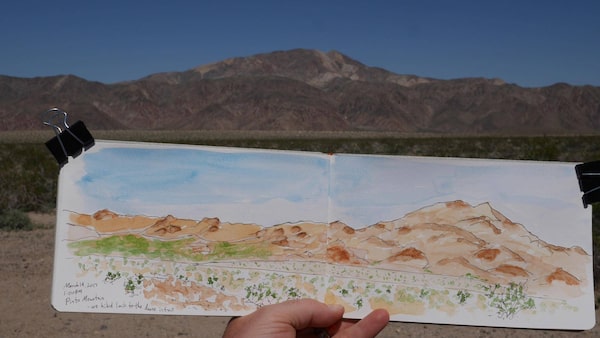
A sketch of Pinto Mountain in Joshua Tree National Park by Trent Bauman.JUANITA METZGER
My husband and I cannot share a camera when we travel. This fact was established fairly early in our 15-year relationship.
Imagine my surprise when, out of the blue, my DSLR-lugging, Instagram snap-happy husband announced he was not bringing a camera on our two weeks of travel to Joshua Tree and the Mojave Desert regions of Southern California. Instead, he added only his sketchbook and watercolour paints to the stack of travel accessories intended for packing.
Now, we are accustomed to low-tech adventures since we regularly travel without mobile devices. But no camera in his backpack? This was a game-changer. I had to know; would this mean an endless stream of requests to "just quickly capture" this or that? Would we need long breaks dedicated to sketching each day? What would I do while he found the perfect spot to "stop, drop and draw?"
We are also "slow travellers," so we tend to travel without a checklist of things to see and do. We opt to keep our days and adventures open and free-flowing. So, not long after the initial "no camera" discussion took place in our kitchen, I was pretty sure this pen-ink-and-watercolour idea just might work.
The sketching began as soon as we arrived at our beloved homesteader cabin just north of the village of Joshua Tree. After five trips to this small desert town, the three-hour backroad route from Las Vegas is so familiar it can be drawn from the mind's eye without the aid of our well-worn map with rips and tears on all the folds.
The sketchbook and watercolours were set by the cabin door at night in anticipation of the hazy orange-pink desert sunrise that greeted us every morning. To capture the Technicolor sunrise quickly and accurately became a daily sport – sometimes successful, sometimes not.
The summit gained on a morning hike or a snack break on a 16-kilometre loop were natural places to break out the sketchbook. With no real agenda except to see what we could see, it never felt like a hardship to stop for 30 minutes while my husband scoped out a desert vista, peculiar rock formation or desert flowers to draw. I brought a book to read; appropriately, Edward Abbey's Desert Solitaire. I wandered off the trail with my camera, in search of old mining debris and wildlife sightings. By the time I would return, a small piece of art was drying on the page. (Incidentally, watercolour dries fast in the dry desert air, which is great for completing multiple paintings in an outing.)
On a Thursday afternoon, we dropped in for lunch at La Copine in Yucca Valley. Being new and popular, the tiny restaurant was packed. We were seated at the counter, only one metre from the chefs working the open kitchen. It felt wrong to pull out my camera in this intimate setting, but the sketchbook was entirely unobtrusive. One of the chefs penned into the drawing turned out to be someone we met at the neighbourhood book club just two days before. She was so pleased to find herself in my husband's lunchtime sketch that they've since found each other on Instagram, of course. Would this connection have happened if I had taken a quick snap with my camera? Not likely.
The sketchbook was an experiment that turned our fifth trip to Joshua Tree into a fresh new adventure. For one thing, sketching and watercolour materials are considerably lighter and less bulky than a digital SLR camera.
More importantly, stay in one spot long enough and you see things that can only be seen by slowing down to a sketching pace. I noticed things differently and noticed different things. It became easy to spot the subtleties of locations we had been before, but never really noticed because we snapped it with a camera and moved on.
We discovered that sketching in public is a great conversation starter. It allows people to initiate conversation after a sidelong glance at the guy sitting on a stool beside the trail with a mini palette of watercolour paints. On two hikes, we encountered other artists painting en plein air. We stopped to talk, of course.
At the end of each day, we could look at the sketchbook and the camera photos, recounting entirely different stories about the images from each medium.
And yes, we discovered that we can, indeed, survive with only one professional camera between the two of us.
Upon our return, I was pleasantly surprised when friends and family were genuinely interested in hearing about our recent travels. Everyone was captivated by the pen-and-ink sketches dabbed and dotted with watercolour. They were less interested in my photos. Maybe I will need to invest in a sketchbook.